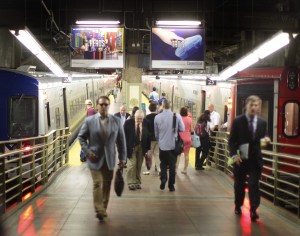Connecticut”™s “Still Revolutionary” campaign continues to raise awareness three years into the state”™s comeback marketing push, according to Deputy Commissioner of the Department of Economic and Community Development Tim Sullivan, who manages the branding effort. Businesses say it has made an impact, but it is hard to tell how much can be attributed to the campaign.
“Any time you”™re talking about a marketing campaign, a perception campaign, it takes a lot of years and certainly a lot of time and a lot of repetition, for it to sink in,” Sullivan said.
In 2012, Connecticut launched a two-year, $27 million campaign to brand the state as a nearby destination with diverse experiences. The campaign has featured more than 130 statewide attractions on television and radio, in print, on outdoor ads and online, targeting consumers in the Northeast.
Sullivan said the state legislature has allocated $19 million for the campaign over the next two years.

- The “Heads and tails” ads in Grand Central Terminal, part of the new campaign, feature the Pez Visitor Center in Orange and the Maritime Aquarium at Norwalk.
Before Gov. Dannel Malloy took office in 2012, the state did not invest in tourism and a lapse in payment toward its Discover New England dues resulted in the organization removing Connecticut from its international marketing campaign.
The lack of attention to tourism promotion “created a higher hill to climb,” according to Sullivan, but he said the campaign has been effective.
The tourism industry in Connecticut supports 118,000 jobs and brought in $14 billion in 2013, a 3 percent or 4 percent increase from 2012, Sullivan said. The tourism sector is growing faster than the rest of the economy in the state, he said, adding summer hotel occupancy is higher than for the rest of New England and for the U.S. as a whole; data will be available later this year.
“I think it”™s important to be consistent and to be continuously marketing the assets of the state,” Sulilvan said. “If you don”™t, people will lose track of you. You”™ll get lost in the shuffle.”
Chris Loynd, marketing director at the Maritime Aquarium at Norwalk, said he remembers being frustrated when Connecticut was not promoting itself. He recalled seeing advertisements for Lake George in New York on TV and thinking, “We need to be in this game.”
The state has featured the aquarium in its campaign, increasing the attraction”™s advertising channels and geographical reach beyond what it could do on its own, Loynd said. He said 36 percent of visitors are from out of state, but nowhere near that amount of his own advertising is out of state.
The state has matched the aquarium”™s investment in advertising, contributing a total of more than $20,000 to billboards, enabling the aquarium to have two this year, and to banner ads on the travel review site TripAdvisor.com.
“When the state doubles it, now I can play,” Loynd said, adding it would not be worth advertising without the matching funds, which enable more repetition.
Loynd has seen an increase in referrals to the aquarium”™s website from CTvisit.com, which features the aquarium. Because it often takes several points of contact for people to decide to visit the aquarium, Loynd said he cannot determine the campaign”™s role in attracting customers. He said Trip Advisor has been helpful because it promotes the Maritime Aquarium when people search for aquariums. The travel review site gave the aquarium a Traveler”™s Choice award this year.
Loynd said attendance numbers have not increased since the campaign launched; in fact, three years ago, attendance numbers were higher than the past two summers. A price increase played a role in the decline, he said. Yearly attendance numbers were in the 500,000 range pre-recession and around 420,000 after the recession. The aquarium has been pulling out of that decline with numbers back in 450,000 range this year, Loynd said.
Tom Armstrong, spokesman for Norwalk-based Tauck, said numbers for the 90-year-old travel company”™s “Hidden Gems of New England” tour, which was redesigned in 2012 to include an overnight stay in Connecticut, have grown over the past three consecutive years.
The tour now includes visiting the Mark Twain House and Museum and the Harriet Beecher Stowe House in Hartford. He said the redesign coincided with the “Still Revolutionary” campaign. Malloy joined in Tauck”™s 2012 announcement of the new tour, which launched in 2013.
Armstrong said Tauck is a big fan of the campaign. While he cannot pinpoint how the campaign has impacted the tour”™s growth ”“ the bump could be due to other states”™ efforts ”” he thinks it has been positive for Tauck and for raising awareness.
“It”™s hard to draw a direct line between the “Still Revolutionary” campaign and the growth we”™ve seen,” Armstrong said. “Many factors drive booking patterns, but the campaign”™s effect can only be positive.”
Loynd said lower gas prices and a better economy also led to an increase in leisure travel. Still, Loynd said, he competes with almost every attraction a family might want to visit.
Sullivan said tourists have more information and more choices than ever. Many states are looking at refreshing their tourism campaigns because it is a big business, he said.
The “Still Revolutionary” campaign differentiates Connecticut by emphasizing it has a diversity of attractions like night life, theater, nature, dining, sports and museums, all within a half hour of each other, Sullivan said. This fall, the state”™s campaign will feature a “Play in Connecticut” theme promoting theaters with discounted specials for October.
Loynd said the campaign has raised the cachet of Connecticut as a place to come and play. Once people enter Connecticut, he has the opportunity to attract them with his own advertising.
“Very few people wake up in the morning and say, ”˜Let”™s go to Norwalk for vacation,”™” Loynd said. “They might wake up in the morning and think, ”˜Connecticut has a lot going on, let”™s go see what to do in Connecticut.”™ That”™s what ”˜Still Revolutionary”™ does for me.”



















